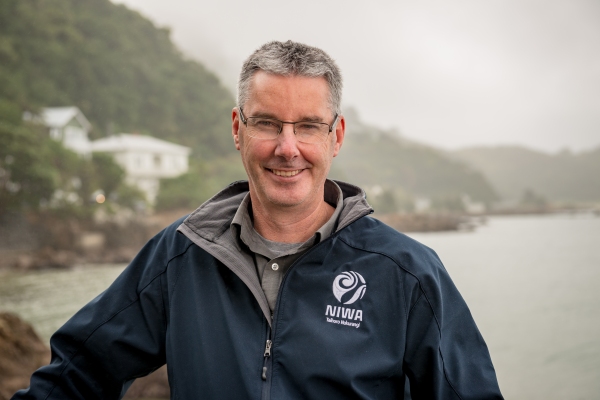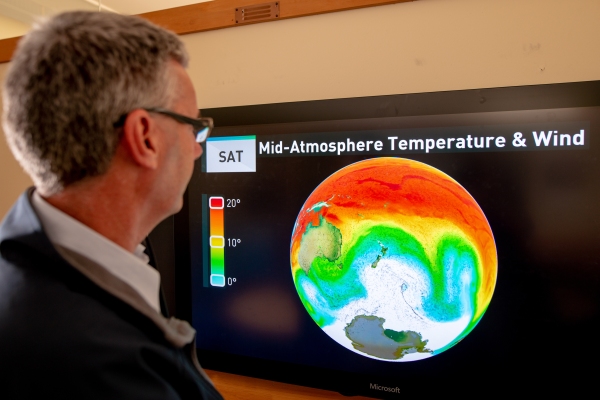A science-fiction fan, amateur actor, and eternal optimist, is now NIWA’s Chief Scientist for Climate, Atmosphere and Hazards. Susan Pepperell finds out more.
"I need to ensure NIWA is doing the right science to benefit New Zealanders."
Dr Andrew Tait
Within the space of a couple of months Andrew Tait has achieved two major milestones: turning 50 and getting a new job. For one his family gave him a fancy barbecue, and for the other, he received a new office with a glimpse of the sea.
If things go in threes, the third will be Tait’s 20th anniversary at NIWA, which will pass on 1 May next year. It’s been an eventful year for NIWA’s newest chief scientist as he takes on a more high-profile role advocating for NIWA’s climate science capabilities and the need for evidence-based decision making.
Tait’s scientific career probably had its origins in high school. The Gore-born, Invercargill-raised boy had a bent for chemistry, but in his first year at the University of Otago it was the climatology component of his geography paper that captivated him.
“Everybody has a way of connecting with the climate. I became interested in looking at climatic patterns and variations across a landscape. Things like where frost forms, and where it doesn’t and how it’s influenced by local airflows and topoclimatic temperature and radiation differences.”
That interest, and a particularly engaging professor Blair Fitzharris, saw him complete not only his bachelor’s degree, but also his masters. Fitzharris also helped smooth the way into a doctorate programme at the University of Colorado in Boulder, where Tait spent four memorable years.
“Boulder is special. I had a fantastic time, and it was there it became obvious what I wanted to do for the rest of my life.”
A year doing post-doctoral research in Bristol, England followed, and then a research scholarship at NASA’s Goddard Space Flight Centre just outside Washington DC. Three years later a friend emailed a job advert for a climate scientist at NIWA and he jumped at it.
Tait is most comfortable describing himself as an applied climate scientist whose interest predominantly lies in answering questions about how businesses, communities or individuals are likely to be impacted by a variable and changing climate.
As chief scientist he has followed in the footsteps of his mentors Drs David Wratt and Murray Poulter and his immediate predecessor Dr Sam Dean, seeing his primary role as working with key stakeholders and end users to provide the expertise they need.
“I need to ensure NIWA is doing the right science to benefit New Zealanders. I also need to support our science teams to build their capability and capacity, and work with them to ensure they have adequate funding for the science to be done.”
He is also keen to ensure that climate science is better understood, so the issues it raises are well grounded in fact. “I am more than happy to be an advocate for the pursuit of scientific evidence and contribute in some small way to a better understanding of what climate change means for all of us.”
However, he also recognises that climate change doesn’t lend itself to optimism.
“I hate being pessimistic about anything. But it really worries me that as a global community we’re nowhere near on track to doing what’s required to keep the impacts of climate change within our coping range.”
That said, he is heartened that the importance of adapting to our changing climate is now much more widely recognised.
“In the past we tended to focus a lot on mitigation, which was needed, but it was unfortunate it came at the cost of thinking about adaptation – these days they’re more on a par and people are coming to the realisation that you can’t do one without the other.”
Unusually for a Crown Research Institute scientist, he has been at the forefront of two government organisations grappling with how to adapt to climate change. Secondments to the Ministry for Primary Industries and the Department of Conservation (DOC) have convinced him of the value of these placements, personally and for the organisations involved.
“One of the big pieces of work I was involved with at DOC was trying to better model climate conditions in beech forests, where warm summers produce much more seed, which increases food supply and results in a pest population explosion.”
These huge seed production events are called masts—Tait’s job was to help work out when climatic conditions would produce a mast and where.
“Masting depends very much on air temperature, so the ultimate aim is to determine which temperature variables are useful to predict masting conditions, and then automate that so it can be used for better management.”
He also worked on a report looking at DOC’s exposure to coastal flooding risk, identifying assets like campgrounds, huts, tracks and archaeological sites that are particularly vulnerable.
“Adaptation is about embedding the right information at the right place. Really, it’s quite simple. You can adapt a lot by just being clever about the way you include climate information into existing processes. If you are thinking long-term, then small changes over time build up to significant benefits, with the ultimate goal of being less vulnerable.”
This month Tait has another new role to perform. A keen amateur actor, he will be playing Gordon Ramsbottom in a play called Little Grimley Presents Strictly Sex Factor (on Ice). The character, Tait says, is a cross between Basil Fawlty and Yes Minister’s Jim Hacker.
He’s also a superfan of science fiction writer Peter F. Hamilton—“I’ve read everything he’s written twice”—and is a keen advocate for Upper Hutt, where he has lived since returning to New Zealand.
“The commute is a bit of a haul, but I’m paying my wife back for her years of commuting around the Beltway when we lived outside Washington DC and my work was across the road while hers was miles away. Mind you after 19 years, I think I might have paid that debt by now.”


